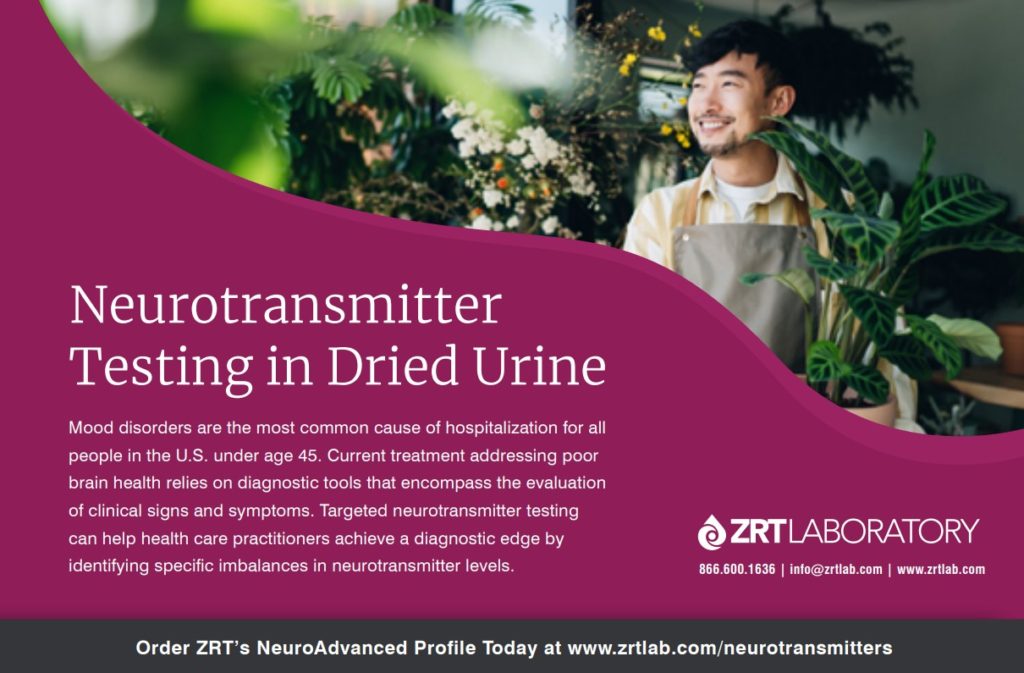By James Greenblatt MD
Irritability and anger are often not well addressed in standard psychiatry. Usually, they are seen as a component of a diagnosis, such as bipolar disorder or depression. As such, irritability and anger are often relegated to the status of symptoms and not directly treated. Yet considering the problems and damage to an individual’s personal and professional life that can stem from irritability, anger, and rage, effective treatment is often critical for better long-term outcomes.
With an almost myopic focus on the patient’s clinical intake interview and symptoms, mainstream psychiatry typically doesn’t investigate physiological causes underlying mental illness. Unfortunately, this often leads to symptomatic polypharmacy—the prescription of numerous medications based on symptoms—and poor treatment outcomes. Unrecognized is the fact that anger issues are often caused by problems with neurotoxicity or nutrient deficiencies. A simple, well-researched example is the psychiatric symptoms associated with lead toxicity. While lead toxicity is an accepted cause of increased aggressive and antisocial behaviors in the research literature,1 it is still infrequently evaluated in clinical settings.2,3
Beyond lead, two other commonly overlooked metals stand out from my own clinical experience due to their relationship with irritability, anger, and rage: lithium and copper. While not officially considered a micronutrient, research suggests lithium is essential, with some researchers giving a provisional recommendation of one milligram per day.4 Data also suggests that individuals deficient in lithium may have an increased propensity towards issues with anger and irritability.5 High-dose lithium has even been explored as a treatment for aggressive behaviors.6-10

And while copper is a necessary micronutrient, too much of the mineral is neurotoxic, contributing to a number of different mental health conditions. Data suggests increased rates of depression in individuals with high copper exposure.11 Wilson’s disease, a cause of elevated copper levels, commonly presents with symptoms of irritability, anxiety, depression, personality changes, and disinhibition.12
Lithium Deficiency and Anger
Lithium, unfortunately, has a bad reputation. Before there was a full understanding of the risks from high-dose use, lithium chloride was introduced as a salt substitute in the middle of the last century. Tragically, liberal use of lithium salt substitutes caused lithium intoxication in some individuals, even leading to death in several cases.13 Additionally, pharmacologic lithium has a risk profile that includes hypothyroidism and kidney damage, which has further tarnished the reputation of the mineral. Due to these concerns, doctors often view lithium with suspicion and avoid prescribing the mineral for any indication.
This negative view of lithium has impeded the utility of lithium in modern medicine. Lithium is a natural mineral, found in low quantities in the environment. Humans have been exposed to lithium throughout our evolution. Consumption of lithium from lithium-containing groundwater to low levels found in fruits, vegetables and other food sources is part of a normal, healthy diet.
For years, data has been building that lithium is a required mineral for maintaining health.14 Research has also found that, for many conditions, low nutritional doses can lead to clinical benefits without the risks from high-dose or standard pharmacological use.
Some of the initial studies documenting reductions in anger and violence with lithium were clinical trials in prison populations. Based on previous animal studies showing reductions in aggression, studies on pharmacological lithium administered to violent prisoners were undertaken. One of the initial studies, a three-month case series with 12 inmates, found reductions in infractions for violent or aggressive behaviors with prescription lithium.7
Based on these short-term results, a separate non-blinded trial on lithium and prisoners with a history of violence both in and outside prison was initiated. In the study, disciplinary action for violent infractions decreased by 77% for individuals treated with lithium.9
This study was followed by a double-blind, placebo-controlled trial on incarcerated males with a history of violence. Lithium treatment significantly reduced threatening and assaultive behaviors over the course of treatment.8 With the positive findings, the researchers suggested that “lithium can have a clinically useful effect upon impulsive aggressive behavior….”8
While well recognized as a treatment in higher doses for bipolar disorder, the prison studies suggest potential for lithium and the reduction of aggressive and violent behaviors. However, nutritional, low-dose lithium is also of relevance for mental health, including in cases of irritability, anger, and aggression. For decades, data has been accumulating that individuals with higher lithium exposure from groundwater have better mental health outcomes. The data also suggests that low-level exposure to lithium reduces aggressive behaviors, both self-directed as suicide and violent behavior towards others.
While initial studies suggested correlations between lower risks of heart disease and lithium in drinking water,15,16 studies soon turned to mental health outcomes. One of the first studies out of Texas found that lithium content in local drinking water ranged from undetectable to 160 micrograms per liter. Mental health hospital admissions and hospital diagnoses of psychosis, neurosis, and personality disorders all inversely correlated with lithium levels. The authors concluded “that naturally occurring lithium exerts a measurable and statistically significant influence on the incidence of patients admitted to our state’s mental hospitals and on…certain diagnostic categories of mental illness.”17 The findings raised significant controversy, with other researchers initially attempting to explain away the results.18
And while some studies contradicted the findings,19 confirmatory data have slowly continued to accumulate. A study in Texas found that counties with higher lithium levels in the water supply, between 70 and 170 micrograms per liter, had significantly reduced rates of suicide, homicide and rape.20 Rates of robbery, burglary, theft, and arrests for opiate or cocaine possession were also inversely correlated with lithium levels.
A study out of Japan found reduced rates of suicide in municipalities with higher lithium drinking water levels. The effect was significant even with low concentrations of lithium, ranging from 0.7 to 59 micrograms per liter and was stronger in males than females.21 The study inspired a watershed of additional studies on the correlation of suicide and lithium levels in drinking water.
A more recent study out of Greece found reduced rates of homicide correlated with drinking water lithium.22 In a similar vein, a study out of Japan found an inverse association with crime and levels of lithium in drinking water.23 A meta-analysis of lithium in drinking water and psychiatric outcomes concluded that suicide and psychiatric hospital admissions are inversely associated with lithium drinking water exposure and recommended more research for other outcomes.24 The population studies included over 100 million individuals.
The data available is incredibly compelling. Lithium, even in microdoses, has clinically relevant effects on psychiatric outcomes. And the data on lithium in drinking water and crime, homicide, suicidality, and drug use strongly suggests that lithium has effects on helping to reduce aggression and violent behaviors. In my own clinical experience, lithium is often key in helping resolve anger issues. While hair testing can sometimes identify individuals that are deficient, I am also suspicious of deficiency in individuals with long-standing symptoms of depression, anxiety, irritability, bipolar disorder, compulsive behaviors and a current or past history of drug abuse or a family history of similar mental health problems. Supplementing low doses of the mineral, between one and 20 milligrams of elemental lithium daily (typically as lithium orotate), often provides noticeable relief.
Copper Toxicity and Anger
Copper, in low quantities, is a necessary micronutrient. It is important for energy production, connective tissue formation, synthesis of the neurotransmitter norepinephrine and other biological functions. It also is inversely related to zinc, with high copper typically corresponding to low zinc and supplemental zinc helping to reduce excess copper.
As stated previously, research suggests that elevated copper plays a role in mental health. A meta-analysis of the studies on copper levels in depressed patients concluded that elevated copper may be a biomarker of depression.11 And while the evidence isn’t as clear, some studies have found associations between high copper-to-zinc ratios correlated to attention-deficit hyperactivity disorder.25 In a similar fashion, studies have also been somewhat mixed on the relationship between copper and aggression. However, a study of young males with a history of assaultive behaviors found a clear elevation in copper-to-zinc ratio as compared to controls. In boys with a history of aggression, the ratio averaged 1.4, whereas in normal controls, the ratio was 1.02.26
The other main body of research that links excess copper to mental illness comes from research into Wilson’s disease. Wilson’s disease is a genetic disorder of copper metabolism. The condition causes a slow accumulation of copper throughout the organs of the body, including the liver and brain. Some of the earliest work to quantify the incidence of mental illness in Wilson’s disease found correlations with a number of symptoms. Some of the strongest correlations were for irritability, aggression, and incongruous behavior, a catch-all term for disinhibition or for engaging in bizarre and reckless activities.27
More recent research seeking to categorize the psychiatric implications of Wilson’s disease and copper excess found similar conclusions. One-third of patients with Wilson’s initially present with behavioral symptoms, which often delays diagnosis. Personality changes in individuals with Wilson’s disease can affect between 46% and 71% of patients. And typical personality changes seen in patients with Wilson’s disease almost always include irritability and aggressiveness.28
Evidence suggests that excess copper, and not the genetic defects, in Wilson’s disease is the cause of mental-emotional symptoms. Studies of patients have found that chelation strategies to reduce copper generally result in improved psychiatric and neurological symptoms.29,30 Based on the published research, and my own clinical experience, copper can and does play a role in initiating and maintaining symptoms of irritability, anger, and rage.
Identifying copper excess can include hair analysis and blood tests, including serum copper, zinc, and ceruloplasmin—a protein carrier molecule for copper in the bloodstream. However, blood levels of both copper and zinc are influenced by recent food intake and other factors. As such, they are not always reliable indicators of nutritional status.31,32
In cases where excess copper is identified, supplemental zinc can often reduce levels and reverse symptoms. Zinc supplementation increases metallothionein, a chelating enzyme that binds certain metals, blocking their gastrointestinal absorption. Metallothionein is more effective at binding copper than zinc. As such, high-dose zinc supplementation can reduce or even deplete copper levels. While higher doses of zinc may be necessary, it’s worth recognizing that doses over 40 mg per day can eventually cause copper deficiency. If severe, copper deficiency can result in anemia and nerve damage.33 It can be important to track copper levels carefully over treatment to ensure patient safety.
Other Causes
While copper and lithium are commonly overlooked causes of anger, irritability, and rage, they aren’t the only causes. In every case, a complete functional evaluation should be initiated. Other contributing factors can include additional nutritional deficiencies, hormonal dysregulation, gut dysbiosis, fetal alcohol syndrome, medication side effects and psychological concerns, including a history of trauma or bullying. For best results, all of the underlying factors need to be addressed.
Medications that are more commonly implicated in increased anger and irritability include selective serotonin reuptake inhibitors (SSRIs) and stimulants. A number of population studies have recently confirmed increased violent crimes for younger individuals prescribed SSRIs.34,35 Stimulant medications can also contribute to aggression. A recent meta-analysis suggests that the risk is mostly associated with amphetamine-based stimulants.36 Regardless, it’s worth keeping medication side effects in mind, especially in cases with worsening irritability or aggressive behaviors after a new prescription or increased dose.
The gut flora is often implicated in mental health concerns, including in cases of anger and aggression. Testing levels of 3-(3-hydroxyphenyl)-3-hydroxypropionic acid (HPHPA) can help identify a subset of individuals with an overgrowth of clostridium that can also contribute to symptoms of aggression and irritability. For a more full discussion on HPHPA, you can refer to chapter 5 in my book Finally Focused. While HPHPA can contribute to more severe symptoms, other causes of dysbiosis may also be present that benefit from treatment.
When addressing anger issues, treating each individual as an individual and identifying the unique factors that need to be addressed can profoundly improve clinical outcomes. In my experience, applying a more comprehensive treatment approach that includes physiological as well as psychological factors consistently yields better outcomes.
Conclusion
Mental illness often has roots in overlooked biological causes. And since irritability and anger are often seen as symptoms, rather than as diagnoses, they are frequently undertreated by standard psychiatry. Two minerals, lithium and copper, can be related to anger and irritability. Proper assessment and treatment of copper and lithium, along with the other underlying factors that affect mental health, can help improve symptoms, leading to better outcomes. Considering the costs of untreated anger issues—including social, professional and interpersonal—patients need additional, effective, and comprehensive treatment. Fortunately, assessing and treating lithium deficiency and copper excess, when appropriate, is typically straightforward and inexpensive. In my experience, it also can help bring relief, especially when combined with a comprehensive functional assessment and treatment.
References
- Needleman H. Low level lead exposure: history and discovery. Ann Epidemiol. 2009;19(4):235-238. doi:10.1016/j.annepidem.2009.01.022
- Kadu AS, Nampalliwar AR, Pande AG, Sharma A, Gothecha, VK. Lead Poisoning: An Overlooked Diagnosis in Clinical Practice. IJRAP. 2012;3(5):639-644. doe:10.7897/2277-4343.03511
- Shabani M, Hadeiy SK, Parhizgar P, et al. Lead poisoning; a neglected potential diagnosis in abdominal pain [published correction appears in BMC Gastroenterol. 2021 Oct 29;21(1):411]. BMC Gastroenterol. 2020;20(1):134. Published 2020 May 6. doi:10.1186/s12876-020-01284-1
- Schrauzer GN. Lithium: occurrence, dietary intakes, nutritional essentiality. J Am Coll Nutr. 2002;21(1):14-21. doi:10.1080/07315724.2002.10719188
- Werbach MR. Nutritional Influences on Aggressive Behaviors. J Orthomol Med. 1992;7(1):45-51.
- Forster PL, Schoenfeld FB, Marmar CR, Lang AJ. Lithium for irritability in post-traumatic stress disorder. J Trauma Stress. 1995 Jan;8(1):143-9. doi: 10.1007/BF02105412. PMID: 7712052.
- Sheard M. Effect of lithium on human aggression. Nature. 1971 Mar 12;230(5289):113-4. doi: 10.1038/230113a0. PMID: 4927008.
- Sheard MH, Marini JL, Bridges CI, Wagner E. The effect of lithium on impulsive aggressive behavior in man. Am J Psychiatry. 1976 Dec;133(12):1409-13. doi: 10.1176/ajp.133.12.1409. PMID: 984241.
- Tupin JP, Smith DB, Clanon TL, Kim LI, Nugent A, Groupe A. The long-term use of lithium in aggressive prisoners. Compr Psychiatry. 1973 Jul-Aug;14(4):311-7. doi: 10.1016/0010-440x(73)90022-9. PMID: 4724658.
- Campbell M, Small AM, Green WH, Jennings SJ, Perry R, Bennett WG, Anderson L. Behavioral efficacy of haloperidol and lithium carbonate. A comparison in hospitalized aggressive children with conduct disorder. Arch Gen Psychiatry. 1984 Jul;41(7):650-6. doi: 10.1001/archpsyc.1984.01790180020002. PMID: 6428371.
- Ni M, You Y, Chen J, Zhang L. Copper in depressive disorder: A systematic review and meta-analysis of observational studies. Psychiatry Res. 2018;267:506-515. doi:10.1016/j.psychres.2018.05.049
- Bandmann O, Weiss KH, Kaler SG. Wilson’s disease and other neurological copper disorders. Lancet Neurol. 2015;14(1):103-113. doi:10.1016/S1474-4422(14)70190-5
- CORCORAN AC, TAYLOR RD, PAGE IH. Lithium poisoning from the use of salt substitutes. J Am Med Assoc. 1949;139(11):685-688. doi:10.1001/jama.1949.02900280001001
- Szklarska D, Rzymski P. Is Lithium a Micronutrient? From Biological Activity and Epidemiological Observation to Food Fortification. Biol Trace Elem Res. 2019;189(1):18-27. doi:10.1007/s12011-018-1455-2
- Blachly PH. Lithium content of drinking water and ischemic heart disease. N Engl J Med. 1969;281(12):682. doi:10.1056/NEJM196909182811215
- Voors AW. Lithium in the drinking water and atherosclerotic heart death; epidemiologic argument for protective effect. Am J Epidemiol. 1970;92(3):164-171. doi:10.1093/oxfordjournals.aje.a121194
- Dawson EB, Moore TD, McGanity WJ. The mathematical relationship of drinking water lithium and rainfall to mental hospital admission. Dis Nerv Syst. 1970;31(12):811-820.
- Pokorny AD, Sheehan D, Atkinson J. Drinking water, lithium and mental hospital admissions. Dis Nerv Syst. 1972;33(10):649-652.
- Oliver SL, Comstock GW, Helsing KJ. Mood and lithium in drinking water. Arch Environ Health. 1976;31(2):92-95. doi:10.1080/00039896.1976.10667197
- Schrauzer GN, Shrestha KP. Lithium in drinking water and the incidences of crimes, suicides, and arrests related to drug addictions. Biol Trace Elem Res. 1990;25(2):105-113. doi:10.1007/BF02990271
- Ohgami H, Terao T, Shiotsuki I, Ishii N, Iwata N. Lithium levels in drinking water and risk of suicide. Br J Psychiatry. 2009;194(5):464-446. doi:10.1192/bjp.bp.108.055798
- Giotakos O, Tsouvelas G, Nisianakis P, et al. A negative association between lithium in drinking water and the incidences of homicides, in Greece. Biol Trace Elem Res. 2015;164(2):165-168. doi:10.1007/s12011-014-0210-6
- Kohno K, Ishii N, Hirakawa H, Terao T. Lithium in drinking water and crime rates in Japan: cross-sectional study. BJPsych Open. 2020;6(6):e122. Published 2020 Oct 15. doi:10.1192/bjo.2020.63
- Eyre-Watt B, Mahendran E, Suetani S, Firth J, Kisely S, Siskind D. The association between lithium in drinking water and neuropsychiatric outcomes: A systematic review and meta-analysis from across 2678 regions containing 113 million people. Aust N Z J Psychiatry. 2021;55(2):139-152. doi:10.1177/0004867420963740
- Skalny AV, Mazaletskaya AL, Ajsuvakova OP, et al. Serum zinc, copper, zinc-to-copper ratio, and other essential elements and minerals in children with attention deficit/hyperactivity disorder (ADHD). J Trace Elem Med Biol. 2020;58:126445. doi:10.1016/j.jtemb.2019.126445
- Walsh WJ, Isaacson HR, Rehman F, Hall A. Elevated blood copper/zinc ratios in assaultive young males. Physiol Behav. 1997;62(2):327-329. doi:10.1016/s0031-9384(97)88988-3
- Dening TR, Berrios GE. Wilson’s disease. Psychiatric symptoms in 195 cases. Arch Gen Psychiatry. 1989;46(12):1126-1134. doi:10.1001/archpsyc.1989.01810120068011
- Carta M, Mura G, Sorbello O, Farina G, Demelia L. Quality of Life and Psychiatric Symptoms in Wilson’s Disease: the Relevance of Bipolar Disorders. Clin Pract Epidemiol Ment Health. 2012;8:102-109. doi:10.2174/1745017901208010102
- Bachmann H, Lössner J, Kühn HJ, et al. Long-term care and management of Wilson’s disease in the GDR. Eur Neurol. 1989;29(6):301-305. doi:10.1159/000116435
- Modai I, Karp L, Liberman UA, Munitz H. Penicillamine therapy for schizophreniform psychosis in Wilson’s disease. J Nerv Ment Dis. 1985;173(11):698-701. doi:10.1097/00005053-198511000-00009
- Klevay LM. Improving accuracy of normal serum copper. J Trace Elem Med Biol. 2016;34:38. doi:10.1016/j.jtemb.2015.10.005
- Wieringa FT, Dijkhuizen MA, Fiorentino M, Laillou A, Berger J. Determination of zinc status in humans: which indicator should we use? Nutrients. 2015;7(5):3252-3263. Published 2015 May 6. doi:10.3390/nu7053252
- Duncan A, Yacoubian C, Watson N, Morrison I. The risk of copper deficiency in patients prescribed zinc supplements. J Clin Pathol. 2015;68(9):723-725. doi:10.1136/jclinpath-2014-202837
- Molero Y, Lichtenstein P, Zetterqvist J, Gumpert CH, Fazel S. Selective Serotonin Reuptake Inhibitors and Violent Crime: A Cohort Study. PLoS Med. 2015;12(9):e1001875. Published 2015 Sep 15. doi:10.1371/journal.pmed.1001875
- Lagerberg T, Fazel S, Molero Y, et al. Associations between selective serotonin reuptake inhibitors and violent crime in adolescents, young, and older adults – a Swedish register-based study. Eur Neuropsychopharmacol. 2020;36:1-9. doi:10.1016/j.euroneuro.2020.03.024
- Stuckelman ZD, Mulqueen JM, Ferracioli-Oda E, et al. Risk of Irritability With Psychostimulant Treatment in Children With ADHD: A Meta-Analysis. J Clin Psychiatry. 2017;78(6):e648-e655. doi:10.4088/JCP.15r10601
A pioneer in the field of functional and integrative medicine, board-certified child and adult psychiatrist, James M. Greenblatt, MD, has treated patients since 1988. After receiving his medical degree and completing his psychiatry residency at George Washington University, Dr. Greenblatt completed a fellowship in child and adolescent psychiatry at Johns Hopkins Medical School. He currently serves as the Chief Medical Officer at Walden Behavioral Care in Dedham, MA.
Dr. Greenblatt has lectured internationally on the scientific evidence for nutritional interventions in psychiatry and mental illness. He is the author of seven books, including Answers to Anorexia, Finally Focused: The Breakthrough Natural Treatment Plan for ADHD, and Functional & Integrative Medicine for Antidepressant Withdrawal.
Dr. Greenblatt was inducted into the Orthomolecular Hall of Fame in 2017 by the International Society of Orthomolecular Medicine. He is also the founder of Psychiatry Redefined, an educational platform dedicated to the transformation of psychiatry, which offers online courses, webinars, and fellowships for professionals. Dr. Greenblatt is the Medical Director of TZ Health, a virtual clinic dedicated to personalized, patient-centered care utilizing a Functional Medicine Model for the treatment of mental illness. Please visit www.PsychiatryRedefined.org and www.tzhealth.com/ for more information.












